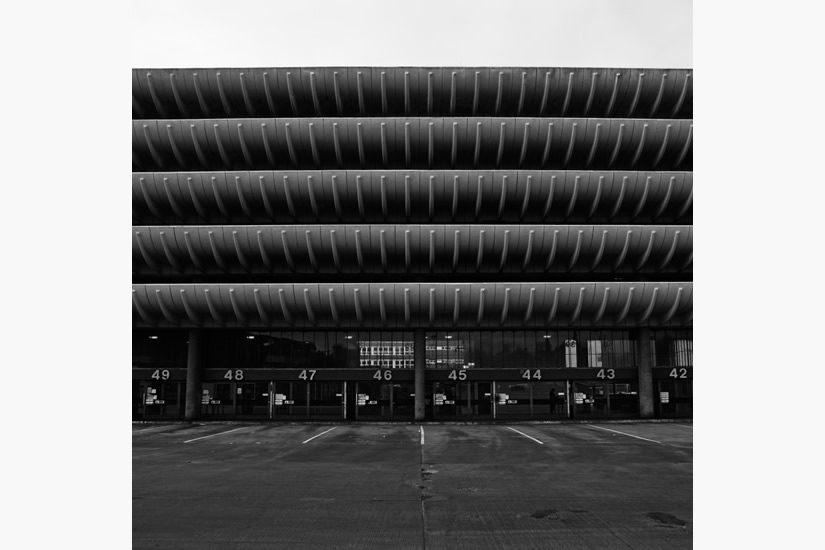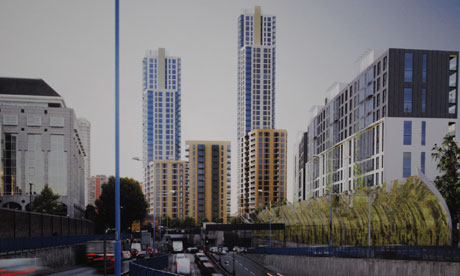This post examines the residential blocks of the eminent architect Erno Goldfinger in the east-end of London. From the 1960's Goldfinger designed a series of buildings for social housing in the east end which included Balfron tower which was similar to his work Trellick tower in the west end, Glenkerry house and Carradale house. His distinctive architectural style, embracing the utilitarian principles of brutalism (too excessively for many) and his work in pioneering high density high rise in the post-war rebuilding of London gives Goldfinger a prominent role in the development of a modern form of living and the development of the brutalist architectural style.
Visiting advice: His works in the east-end are all in very close proximity to each other and can be visited at the same time. If you are interested in a visit my suggested route is to getting off at Blackwell (the DLR station) and attempt to walk via Robinhood gardens - another iconic but less appreciated icon (shortly to be demolished!), then follow the A12 north until you find the clearly visible blocks - it is not difficult to miss them! Also - best to go in warmer weather!
Balfron Tower

Balfron Tower, the tallest and most distinguishable of the group bares a striking similarity to trellick tower in the west end, these blocks were built in the late 1960's just prior to the completion of Trellick tower The most iconic feature of this building and of Goldfinger's social housing are the detached Lift towers which are given a grandeur and monumentality. The design is both functional and aesthetic, functional in the sense that having a detached lift (and services) tower isolates the noisy parts of the building such as the lift, rubbish shoots, the boiler room and (in the past at least) washing facilities away from the main living accommodation. The maisonette structure in which access to the flats is on every third floor is also function in that it both reduces the cost in construction of the lift (often the practical reason for maisonette structures in post-war rebuilding - primarily pragmatism rather than aesthetic or ideological) and reduces the number of lift stops, saving time. Despite the purely practical nature of the design it never-the-less creates the iconic feature of the block, a clear illustration of the ideological utilitarianism of the brutalist style.
The tower will shortly undergo a restoration and modernization before the flats are 'privatized' and sold off. The nature of this process is inevitably controversial with the accusations of social cleansing - often justified. It will be interesting to see whether these flats formerly used for social housing will attract the middle class professionals which Trellick tower certainly has in the last twenty years after the same treatment. Brutalist architecture certainly is becoming more desirable however the extent to which these flats do become 'gentrified' will only become apparent in a few years time.
Glenkerry House

Glenkerry house is the shorter neighbour of Balfron tower although its structure and plan is much the same as the latter, the flats are designed as maisonettes although with a 'semi'-detached lift tower, physically joined to the building on all floors (unlike Balfron and trellick towers) although set at a right-angle to the main walkways. Glenkerry house lacks the height which creates interest (although I acknowledge its proximity to Balfron tower may have restricted its height) and when viewed from green it overlooks it is in my opinion somewhat underwhelming. Unlike Trellick and Balfron the lift tower although still a key feature of the building is less successful as in the former with there detached towers with walkways int he sky creates the monumental and iconic image of the building and is the main distinguishing feature. The iconic detached lift tower which creates the landmark status of the fore-mentioned towers. In my opinion it lacks conviction and is a watered down version of Balfron tower and in such proximity it is inevitably overshadowed by that building - both literally and metaphorically, Glenkerry cannot (in my mind) decide its form, high rise or low rise it (opting for somewhere in the middle) which does not express the confidence and conviction which makes brutalism so stimulating and controversial. Despite this, that is not to say the building is without merit and if viewed without a inevitable comparison with its neighbour it does still assert its own distinctive character.
Balfron Tower

Balfron Tower, the tallest and most distinguishable of the group bares a striking similarity to trellick tower in the west end, these blocks were built in the late 1960's just prior to the completion of Trellick tower The most iconic feature of this building and of Goldfinger's social housing are the detached Lift towers which are given a grandeur and monumentality. The design is both functional and aesthetic, functional in the sense that having a detached lift (and services) tower isolates the noisy parts of the building such as the lift, rubbish shoots, the boiler room and (in the past at least) washing facilities away from the main living accommodation. The maisonette structure in which access to the flats is on every third floor is also function in that it both reduces the cost in construction of the lift (often the practical reason for maisonette structures in post-war rebuilding - primarily pragmatism rather than aesthetic or ideological) and reduces the number of lift stops, saving time. Despite the purely practical nature of the design it never-the-less creates the iconic feature of the block, a clear illustration of the ideological utilitarianism of the brutalist style.
The tower will shortly undergo a restoration and modernization before the flats are 'privatized' and sold off. The nature of this process is inevitably controversial with the accusations of social cleansing - often justified. It will be interesting to see whether these flats formerly used for social housing will attract the middle class professionals which Trellick tower certainly has in the last twenty years after the same treatment. Brutalist architecture certainly is becoming more desirable however the extent to which these flats do become 'gentrified' will only become apparent in a few years time.

Glenkerry house is the shorter neighbour of Balfron tower although its structure and plan is much the same as the latter, the flats are designed as maisonettes although with a 'semi'-detached lift tower, physically joined to the building on all floors (unlike Balfron and trellick towers) although set at a right-angle to the main walkways. Glenkerry house lacks the height which creates interest (although I acknowledge its proximity to Balfron tower may have restricted its height) and when viewed from green it overlooks it is in my opinion somewhat underwhelming. Unlike Trellick and Balfron the lift tower although still a key feature of the building is less successful as in the former with there detached towers with walkways int he sky creates the monumental and iconic image of the building and is the main distinguishing feature. The iconic detached lift tower which creates the landmark status of the fore-mentioned towers. In my opinion it lacks conviction and is a watered down version of Balfron tower and in such proximity it is inevitably overshadowed by that building - both literally and metaphorically, Glenkerry cannot (in my mind) decide its form, high rise or low rise it (opting for somewhere in the middle) which does not express the confidence and conviction which makes brutalism so stimulating and controversial. Despite this, that is not to say the building is without merit and if viewed without a inevitable comparison with its neighbour it does still assert its own distinctive character.
After passing from control of Tower Hamlets council (which is a relief considering their record for the care of brutalist architecture - see Robin Hood gardens!) the building is now run by an independent housing cooperative.
Carradale House

Built in the same style as his other works although a horizontal rather than vertical display of his approach to social housing. Although evidently less impressive than Balfron tower unlike the Glenkerry house it has I think more conviction in its form (a long and low block). It has a good relationship with its neighbour Balfron tower (see left) and creates some clear continuity. It also displays the instantly recognizable detached lift tower with the small vertical arrowslit windows and again takes a prominent place asserting again the utilitarian character and nature of the building.

Carradale House

Built in the same style as his other works although a horizontal rather than vertical display of his approach to social housing. Although evidently less impressive than Balfron tower unlike the Glenkerry house it has I think more conviction in its form (a long and low block). It has a good relationship with its neighbour Balfron tower (see left) and creates some clear continuity. It also displays the instantly recognizable detached lift tower with the small vertical arrowslit windows and again takes a prominent place asserting again the utilitarian character and nature of the building.





























